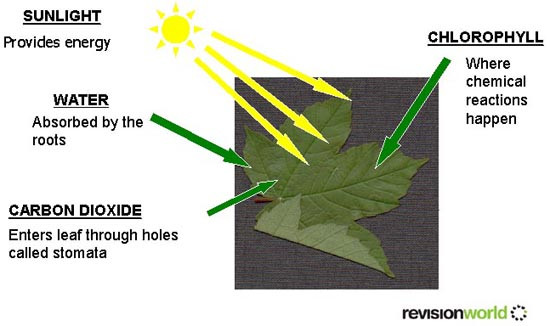Photosynthesis is the chemical change which happens in the leaves of green plants.
- It is the first step towards making food.
- During this reaction, carbon dioxide and water are converted into glucose and oxygen.
- The reaction requires energy in the form of sunlight, and chlorophyll must also be present.
- Plants are producers – they produce their own food
- Plants produce their food via photosynthesis

Photosynthesis occurs in the leaf
Needs
- Chlorophyll – not used up
- CO2 (from the air)
- Water (from the soil)
- Sunlight energy (any light except green light) – not used up
Produces
- Glucose
- Oxygen (waste product)
This video explain more about Photosynthesis and plant nutrion
Factors affecting Photosynthesis
Three factors limit photosynthesis from going any faster
1. Light level - Without enough light a plant cannot photosynthesise very fast, even if there is plenty of water and carbon dioxide. Increasing the light intensity will make photosynthesis faster.
2. Carbon dioxide level - Photosynthesis can be limited by the level of carbon dioxide. Even if there is plenty of light a plant cannot photosynthesise if it has run out of carbon dioxide.
3. Temperature - If it gets too cold the rate of photosynthesis will slow right down. If it gets too hot then plants cease to be able to photosynthesise.
Night time versus Daytime
Daytime
Photosynthesis & Respiration
Night-time
No sunlight therefore no photosynthesis - Only respiration
